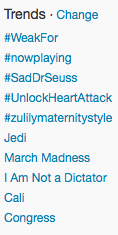 Using Twitter as a recruiting tool appears to be deceptively simple: develop a large following and start tweeting. Simple enough, but success doesn’t come easy. The 140-character limit doesn’t allow for much more than broadcasting jobs. But just shooting of links to job postings means that only the most active candidates will respond. So what is likely to make a tweet more interesting to the passive candidate — i.e., the vast majority?
Using Twitter as a recruiting tool appears to be deceptively simple: develop a large following and start tweeting. Simple enough, but success doesn’t come easy. The 140-character limit doesn’t allow for much more than broadcasting jobs. But just shooting of links to job postings means that only the most active candidates will respond. So what is likely to make a tweet more interesting to the passive candidate — i.e., the vast majority?
What to Tweet
Researchers at Carnegie Mellon and MIT found that the tweets most likely to be read are those sent as questions to followers, and information sharing. General conversation or status updates are the least popular. That is, rather than just send job postings, send out information that has value to the reader. It’s difficult to find content that appeals to followers with diverse interests, so recruiters should focus on groups that can be categorized by interests — gather followers who already have a lot in common. Other research done at CMU shows that the likelihood of a tweet being read has a lot to do with how closely the followers identify with the author. Users are most likely to read tweets from individuals they follow. They are less likely to read tweets they find through Twitter searches and search engines.
As the saying goes, content is king. But there isn’t a person on the face of the planet who has enough interesting things to say on a regular basis to create a following on Twitter. Still, there’s no reason that tweets have to be original — they can be curated content, a source of information and conversation around a specific topic. The researchers at CMU and MIT recommend embedding more context in tweets (and being less cryptic); add extra commentary; don’t overuse hashtags, and use direct messages rather than @mentions. And make sure that questions use a unique hashtag so followers can keep track of the conversation.
Building a Community of Followers
Unlike Facebook and LinkedIn, one can’t just search for profiles (finding potential followers can be done as simply as running a search on Twitter for anybody discussing a specific keyword, which can produce thousands of contacts). Start following them and a good percentage will follow you back. Twitter’s own recommendation engine works pretty well but other resources that can be used to grow your followers include Wefollow.com. This is a directory of Twitter users where you can list yourself under appropriate categories so others can find you.
Hootsuite is another product that can help in growing followers by keeping them engaged; the best feature is prescheduling tweets. Socialoomph does the same. Having a regular stream of tweets typically increases followers and keeps current followers more engaged. Tweepi is another great resource for building a following. It applies Twitter rules to allow you to follow a certain number of people on Twitter at a time. For example, if recruiting for healthcare professionals, pick the name of an influential person in the field (Mike Ryan is an expert on healthcare), type in their Twitter handle, and you can immediately start following forty of his followers. And use Buzzom.com to flush out those who aren’t following you back.
Following the above advice will likely yield much better results for recruiters, but any recruitment efforts involving Twitter should be put in context to have realistic expectations. Only 15% of adults online use Twitter, and only about half of those do so on a daily basis. That still a lot of people — about 13 million — but that group is heavily skewed towards younger adults (ages 18 – 29) and certain minorities. So temper your expectations accordingly.